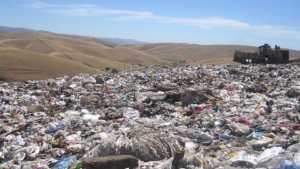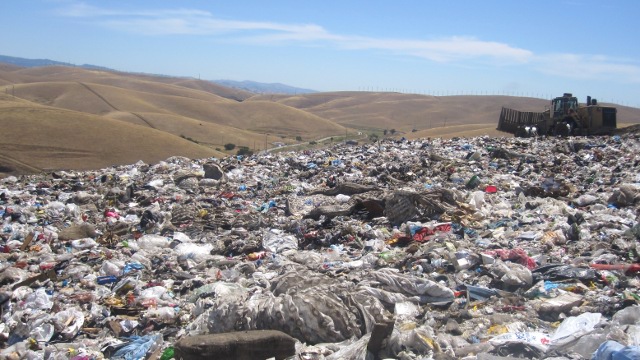But a couple months ago, Coleman ran out of gas money and was late to her classes at nursing school. She wasn’t finding part time work. And that’s when she started getting a lot more enthusiastic about garbage. A few weeks ago, she made eighty dollars collecting cans and bottles from family members’ homes and around her complex, and bringing them to Alliance Recycling, a buy-back center in Emeryville.
“Recycling is making the way for me now,” she says. “I guess it’s my job.”
That’s true of a lot more people than it used to be, says Jay Anast, who owns Alliance Recycling. A few years ago, the only people who came in here were were pushing shopping carts. Now, he’s seeing late model Toyotas.
“Since the economy burst,” says Anast, “we’ve seen more of your middle-class types. We’re getting quite a bit of that now.”
A lot of this stuff would have been put out on the curbside and recycled anyway. But some of it wouldn’t have, which is one reason that recycling rates across the country have soared, according to Jerry Powell, who edits Resource Recycling Magazine, based in Portland, Oregon.
Powell says nationwide, 58 percent of aluminum cans are recycled, the highest rate in 11 years. Soon, he predicts, more cans will be recycled than ever before.
Here in California, the rates are even higher, thanks in part to the state’s bottle bill, which puts a five-cent redemption value on every aluminum, glass, and plastic beverage container, from soda cans to water bottles. (You can see which 11 states in the US have bottle bills on this map.) Last year, 82 percent of cans and bottles sold in California were recycled. That’s up from 55 percent in 2003.
People are recycling vastly more than they used to. It’s a big shift. Recycling was once the icing. Now, it’s the cake. And no where is this change as stark as it is in San Francisco, where the city now recycles or composts almost 80 percent of its waste, sending 30 percent to the landfill. “Fifteen years ago, it was completely the opposite,” says Powell.
As a result of both high recycling rates, and increasing scarcity of natural resources, recycling is a bigger part of our economy than it has ever been before. Entire industries, here, and abroad, literally can’t survive without those bottles, cans, and cardboard boxes you put on the curb, or bring to a recycling center.
“If the total recycling industry said ‘stop,’, says Powell, “ you wouldn’t have an American car made. They’re mainly made out of recycled steel. You wouldn’t have beverages as we have today. You’d have half the newspaper, because you could only get half the paper. Recycling is now just part of the normal economic order.”
But when people start recycling even more and throwing away less, there are growing pains.
For example, Berkeley. For years, the city billed residents for garbage pick-up. Recycling was free, as a way of encouraging people to do more of it. But when people started throwing away less garbage, the city’s revenues dropped. The city has raised garbage rates three times in as many years.
And then, consider the landfills.
Under a baking blue sky at Altamont Landfill, near Livermore, a bulldozer rakes over the days’ trash. It’s been trucked up here from San Francisco and Alameda County and is now being crushed into the hillside.
Ken Lewis, area director for this landfill, and I stand on a massive pile of old garbage. It contains almost every scrap of trash tossed by San Francisco residents for the past 30 years.
In the industry, it’s called “municipal solid waste,” says Lewis, “paper, organic materials, plastics, film plastic bottles, a lot of materials you’d find in any household that’s been thrown out over the last years.”
But times have changed. Almost every one of those things is now recyclable, which means, more and more, they aren’t ending up here. Add the fact that, in a recession people buy less stuff, and you have a landfill that’s taking in about two thirds of what it accepted in 2000, says Lewis. He says volumes are way down from San Francisco, Alameda County, and virtually every other jurisdiction as well.
Once upon a time, California’s politicians warned about a landfill crisis. Now, the state finds itself with enough existing landfill space to last nearly 50 years.
But it also means that, as garbage sent to landfills, decreases, the companies that run the landfills must find ways to diversify their businesses. They must find ways to make a profit off of not throwing stuff away.
Houston-based Waste Management, which owns the Altamont landfill, is a good example. Over the last few years, the company has been buying up composting facilities across the country. It runs more recycling operations than any other single company.
And a couple years ago this landfill took a step ahead of any other such site in the country. It opened up the first landfill-gas-to-liquid-natural-gas facility in the country. This way, the company can benefit from all those rotting banana peels inside the landfill. As the garbage decomposes, it lets off natural gas, including methane. The landfill has built a facility to suck these gasses out of the landfill, and send them to a processing facility, where they’re converted into liquid natural gas.
This gas now fuels Waste Management’s trucks.
[jwplayer config="QUEST Video Player Inline II" mediaid="19771"]
 Monet Coleman, I think it’s fair to say, is not your average dyed-in-the-wool, tree-hugging environmentalist. She says until recently, “I never thought to recycle. Ever.”
Monet Coleman, I think it’s fair to say, is not your average dyed-in-the-wool, tree-hugging environmentalist. She says until recently, “I never thought to recycle. Ever.”